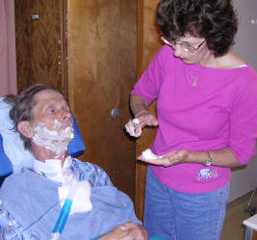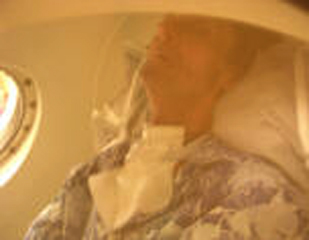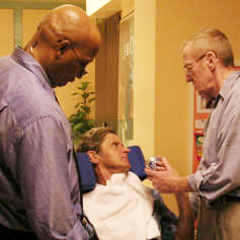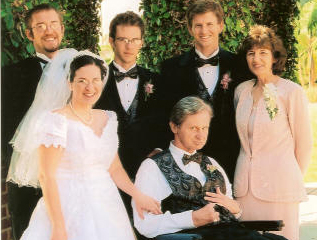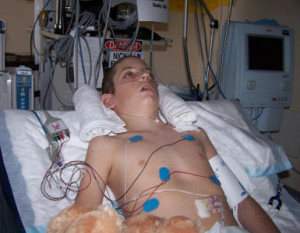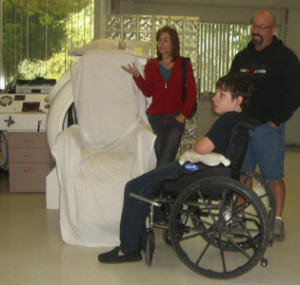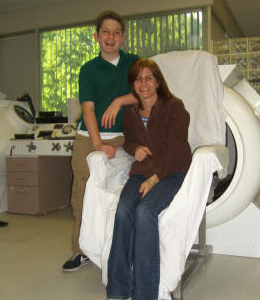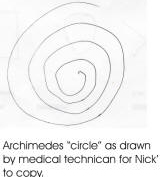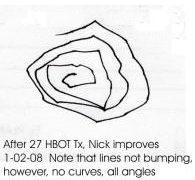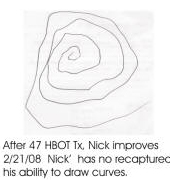Hyperbaric Oxygen Therapy (HBOT) is a non invasive and painless treatment that makes you heal faster.
Understand the diagnosis and defy the prognosis!
The discovery that the mind can change the brain, momentous as it is for such practical matters as helping stroke patients, is only the beginning. Finally, after a generation in which biological materialism has had neuroscience in a chokehold, we may at last be breaking free.”
The Mind and The Brain – Neuroplasticity and the power of Mental Force. The author, Jefferey M. Schwartz, M.D. is a research professor of psychiatry at UCLA School of Medicine.
Hyperbaric Oxygen Therapy (“HBOT”) will:
• increase range of motion,
• increase oxygen delivery to injured tissue, including brain and spine,
• result in rapid reactions to other rehabilitation strategies, such as speech and physiotherapists.
HBOT is available in hospitals. However, hospitals usually will not treat illnesses such as stroke in their chambers. We provide hospital standard treatments at an affordable price. We incorporate the latest research and modern technology to cross frontiers in treating traumatic brain injury and cerebrovascular accidents such as stroke and heat attacks. The atmosphere in our clinic is relaxed and comfortable, designed to assist and enhance recovery.
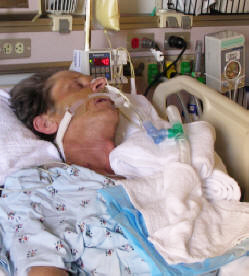
Stephan (“Steve”) K
Stephan (“Steve”) K’ was a fit 53 years old who worked in the construction industry. He did not fit any risk category for heart attacks when he had one. On April 23, 2004, Steve was driving with his daughter Jackie. He stopped at the curb and opened his pickup’s door and fell to the ground, apparently dead with no heartbeat and no breathing. Jackie raced to her father’s body and commenced CPR. Steve’s heart started to beat and ragged breathing commenced.
Steve was rushed to Emergency by an ambulance and placed on full life support. His wife Kathy arrived and was told by the Hospital’s staff that there was little or no hope for Steve and that she should give them permission to take him off life support so “Steve can give life to others” as an organ donor.
... more
Kathy, a devout Catholic, refused to let go of her husband of 33 years. Despite the fact that Steve had once made the remark “if ever I am on life support, pull the plug on me,” she later recalled thinking that it was God that would make that decision, not her. Kathy and her adult children prayed as though Steve’s life depended on God, and worked as though his life depended on them.
Steve had stabilized enough to be transferred to a skilled nursing facility. Thirty-eight days after his heart attack, and against the protests of the nursing staff, Kathy bundled the comatose Steve into a van and brought him for his first Hyperbaric oxygen treatment to Hyperbaric of San Diego’s Clinic. Over the next six weeks Steve came to the Clinic every second day for a 90 minute session in the chamber. On his sixth treatment, the Clinic staff noted that Steve seemed to be responding to voices. The challenge for Kathy each day was to prod a skeptical nursing staff at the convalescence home into getting Steve prepared for travel. “They continued to insist that there was no hope and that all life support efforts be curtailed so he could be an organ donor. It was extremely stressful on me to have such a gloomy prognosis repeated and in front of Steve also,” Kathy commented later.
Steve was considered to be “brain dead” by his neurologists. Regular rehabilitation therapies (speech and physical) were denied by his insurance company. Kathy, a schoolteacher, moved Steve out of the skilled nursing facility back into his home. She purchased a disabled van and hired a caretaker for the hours that she was away from home. Steve now had problems holding himself erect in his wheel chair and needed to be held in an upright position with tie-downs. Kathy wheeled Steve into the hyperbaric clinic each Saturday and Sunday.
One of the first indications that Steve’s brain was functional was when he was offered a taste of beer. Under the watchful gaze of an attending physician at the hyperbaric clinic, Steve opened his eyes and indicated “yes” to the question “would you like a beer, Steve?” Just a sip of the remembered flavor stimulated Steve’s gag reflex and he commenced spending more time with his eyes open and trying to talk. The tracheotomy was no longer needed and removed. The stoma closed over rapidly. On each of his weekly visits to the Clinic, the staff noted continual progress. By this time Steve had completely reversed himself on his pre-stroke comment about “pulling the plug” if he ever became so gravely ill. When he was still unable to sit up, a relative leaned over him and asked “Do you want to be allowed to die?” to which Steve grimaced and whispered “Noooo.”
Fifteen months after his heart attack, Kathy and Steve visited his original neurologist. By this time, Steve was now fully responsive, remembered the doctors name and said “Hullo, Doctor” when he was wheeled into the office. The specialist physician was both amazed and pleased. “It is now obvious that Steve had a stroke rather than a myocardial infarct. He is a man in a barrel. ” The neurologist then agreed to full stroke rehabilitation for Steve at the insurance company’s cost. “It could be up to five years before he is able to walk,” the neurologist cautioned Kathy.
Steve continues to progress. Steve has a lively interest in life and a wry sense of humor. He enjoys spending time with his grandchildren and they love him.
One of Steve’s sons, Jonathan, toasted his sister Jackie at her recent wedding, 4th of July weekend, 2005.
“My sister is the third strongest woman that I know, after my grandmother and mother. Without her efforts to resuscitate Dad, he would not be here today. My Dad had often told me that you should never go to bed at night without telling your family that you love them”.
This was in response to Steve holding the microphone and toasting his daughter and saying “I love you.”
Steve’s determined and stoic wife Kathy is one of the Clinic’s heros. Families and friends, wives like Katy, the parents and care-givers are Heroes in our eyes. We encourage you to click here to visit just some of the Heroic care givers that have graced our Clinic. Look for Kathy and Steve on Thanksgiving at the Clinic.
It is amazing how quickly life can change. One minute you are a living, active, happy person and the next you are frozen in your mind and body dependant on everyone for everything. Unfortunately things cannot be reversed as quickly. It is a slow, painstaking process with each little milestone celebrated.
Steve was given a 2% chance of survival and a 10% chance of recovery. The family was advised there was little hope – we did not give up.
I faithfully bring Steve to his hyperbaric oxygen treatments each weekend and see him change from a comatose being to a man that slowly whispers “I love you.”
Kathy Kakacek, July 2005
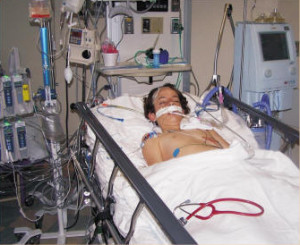
Nick
Nick hovered in a coma for five weeks in San Diego Children’s Hospital. When he eventually awoke, he was unable to talk or walk. Was Nick’s life “over” in a normal sense? His parents refused to believe so and their research led them to hard-chamber hyperbarics. Nevertheless, the pediatric neurologists at the hospital were not experienced in the use of HBOT for strokes and were reluctant to write the needed prescription for ‘Nick to commence treatments.
However, the Hospital’s pediatric rehabilitation specialist was familiar with the benefits of HBOT on stroke patients and strongly encouraged the family to find a center to treat ‘Nick. The specialist physician happily wrote the prescription. Next, the North Carolina Children’s Charity “Gracie’s Hope” also stepped in as angels and granted the family enough for 100 HBOT treatments.
After 25 HBOT Tx. Nick was able to stand. His speech improved. By 45 HBOT Tx. Nick is now graduating from wheel-chair-walking frame and is now using forearm crutches. Nick has enrolled in High School and will attend like any other student his age. Apart from the subjective observations of his parents and the San Diego Healing Chambers staff, Nick’s progress can be clearly seen by using “Archimedes expanding-circle” graphs.
Scott
Can HBOT help in the rehabilitation of traumatic head injury? YES
The saga of Scott Everland, injured in a high school football game. Scott is being treated with hyperbaric oxygen therapy with a grant from Gracie’s Hope.
PROGRESS REPORT – September 16, 2009. Scotty is now making the news again. Featured on the front page of the sporting section of the San Diego Tribune and in this weeks television report.
Courage, endurance, determination and love can banish the bleakest prognosis …

